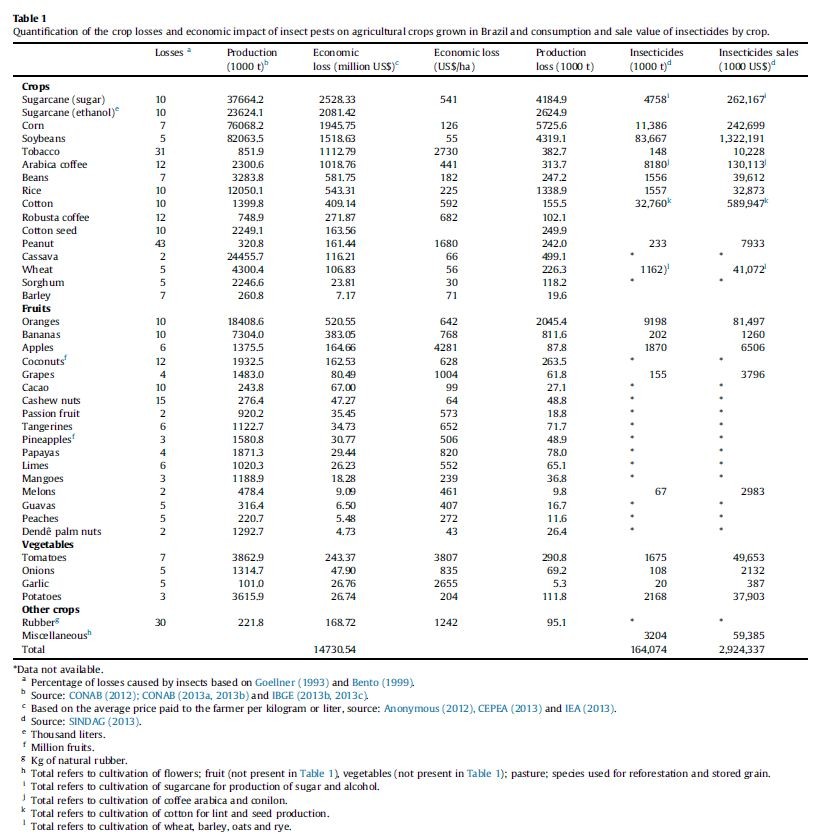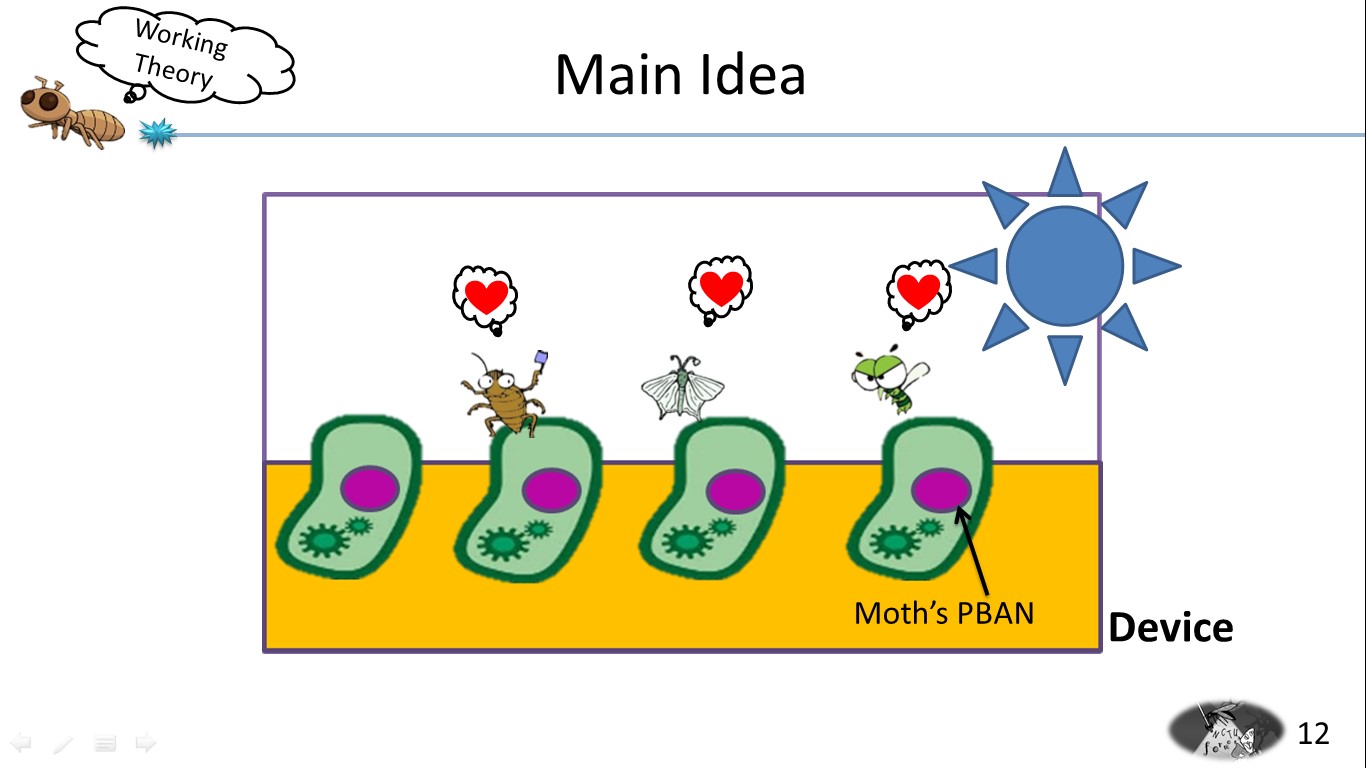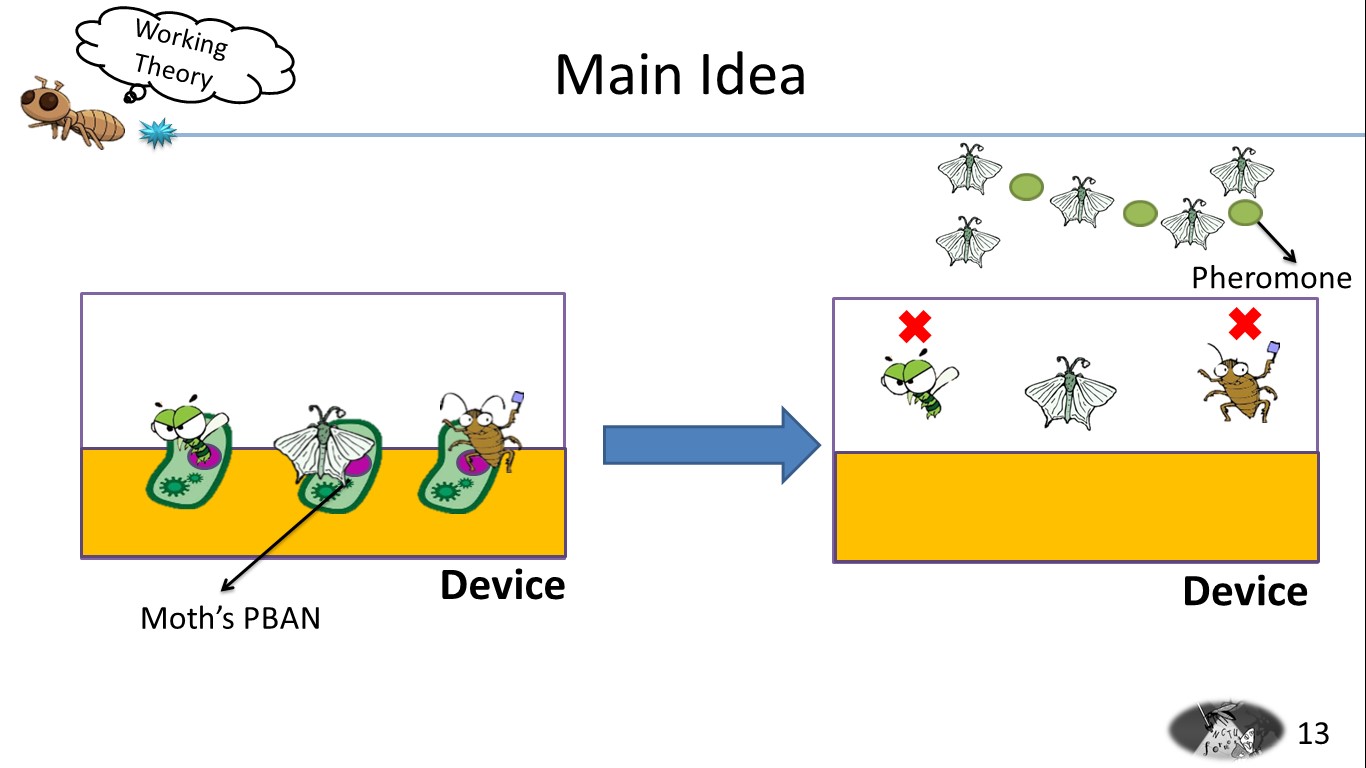Team:NCTU Formosa/project
From 2014.igem.org
Alex19950425 (Talk | contribs) (→Design) |
Alex19950425 (Talk | contribs) (→Design) |
||
| Line 149: | Line 149: | ||
[[File:Acrylic.jpg|450px|thumb|left|]] | [[File:Acrylic.jpg|450px|thumb|left|]] | ||
| + | |||
| + | |||
Revision as of 06:20, 7 September 2014
Contents |
Overview
Impact of pest
In agriculture, insect problems have existed for a long time, and have been difficult to be solved. In addition, all agricultural products on earth every year suffer from harm and damage caused by these insects. Therefore, it goes without saying that insect problem can be regard as a global economic problem.
Losses caused by pests on crops include direct damage, drug costs and the experimental costs, The loss which is most difficult to estimate is the consumption of medical resources on human health hazards caused by pesticides.
We can see this credible chart, insect damage recorded in Brazil region, pests generally reduce crop yields by 10 percent, which is each crop have reduced the value of hundreds of millions. Our goal is committed to reducing agricultural losses, safeguarding human health, and maintain ecological balance.
Pesticide hazards
Because of the hazard of insects, human beings to make a lot of ideas to kill these harmful insects. In 15th century,people used heavy metals to kill harmful insects,such as Arsenic,Mercury and Plumbum, which caused a catastrophe to the environment.
Pesticide becomes more powerful along with the technology, in 20th century,the agriculture develops rapidly just because of the evolution of pesticide. But the pesticide is not only harmful to the insects but also harmful to the human beings. People found this problem after several decades. The toxin of the pesticide will be kept in creatures by the food chain,and finally go into human's body.
However, it's not too late to improve this situation. We can create an evolution of agriculture by a new method,and it is what we do!
Solution to both questions
It needs pesticides to eliminate the pests, but the use of pesticides will hurt environments and cause harm to humans. Thus there have been conflicting issues, and have been difficult to be solved. In order to solve the above-mentioned problems, we came up with a practical, inexpensive way.
Reference
PBAN(Pheromone Biosynthesis Activating Neuropeptide)
Introduction
PBAN(Pheromone Biosynthesis Activating Neuropeptide) is one kind of peptide that can activate biosynthesis of pheromones of many kinds of insects. Once a PBAN binds with the G-protein coupled receptor on an insect’s pheromone gland, biosynthesis would be activated and pheromones will be synthesized and emitted.
Features of PBAN
1. PBAN is species-specific just like pheromones, that means every kinds of insects which can produce pheromone have it's specific PBAN,which can only bind with it's specific receptor and only stimulate the biosynthesis of a specific pheromone.
2. The coding sequence for a PBAN is usually around 100 basepairs. Thus, it is easy for E.coli to express. We can even combine several different PBAN sequences into one BioBrick assembly. (Check this out at our BioBrick page)
PBAN in nature
In nature, female insects such as moths release PBAN during mating to stimulate the synthesis of pheromones in order to attract their male counterparts. PBAN can also facilitate the release of non-sex pheromones such as trail pheromones for ants.
How are we going to use PBAN?
In our project, we will biologically synthesize PBAN with our E.coli. We store the PBAN inside a trapping device (check this out at our Device page). In the device, there will be appropriate lighting and nutrient sources that will attract insects.
Once an insect is attracted into our device and ingests the nutrient sources we provide, it will also inevitably come in contact with our PBAN, which is evenly mixed with the nutrient sources. As the PBAN works its magic and activates the pheromone synthesis of the attracted insect, more of this species of insect’s counterparts will be attracted and later captured.
Reference
- part BBa_I15008;MIT Registry of Standard Biological Parts
- part BBa_I15009;MIT Registry of Standard Biological Parts
- Miriam Altstein, Role of neuropeptides in sex pheromone production in moths,Peptides 25 (2004) 1491–1501.
- Ada Rafaeli, Pheromone biosynthesis activating neuropeptide (PBAN): Regulatory role and mode of action, General and Comparative Endocrinology 162 (2009) 69–78
- Ronald J. Nachmana, Peter E.A. Teal, Allison Strey, Enhanced oral availability/pheromonotropic activity of peptidase-resistant topical amphiphilic analogs of pyrokinin/PBAN insect neuropeptides, Peptides 23 (2002) 2035–2043
- Russell Jurenka1 and Ada Rafaeli, Regulatory role of PBAN in sex pheromone biosynthesis of heliothine moths, frontiers in ENDOCRINOLOGY, published: 10 October 2011 doi: 10.3389/fendo.2011.00046
- Dr. Ashok K. Raina andJulius J. Menn, Pheromone biosynthesis activating neuropeptide: From discovery to current status, Issue Archives of Insect Biochemistry and Physiology, Article first published online: 7 FEB 2005 DOI: 10.1002/arch.940220112
- Man-Yeon Choi and Robert K. Vander Meer, Ant Trail Pheromone Biosynthesis Is Triggered by a Neuropeptide Hormone, PLoS Onev.7(11); 2012PMC3511524
Biobrick Design
We searched the DNA sequences of the PBANs from many kinds of moths on NCBI, then contrasted to the amino sequences from papers so that we can selected the DNA fragments which directly correspond to gland-stimulating function, By ligating the Ribosome binding site(B0034) and PBAN DNA sequence, we were able to make E.coli directly produce these PBANs instead of the original complex process of PBAN biosynthesis in insects. We had gotten nine kinds of PBANs, each of which is from one kind of moth ,after we constructed the PBAN biobricks, the B0034+BFP+J61048 biobrick was ligated behind the PBAN biobrick in order to make modeling each PBAN biobrick respectively more easy in the future and observing the production of PBANs more convenient for us.
Reference
- Torsten Waldminghaus, Nadja Heidrich, Sabine Brantl and Franz Narberhaus .(2007). FourU: a novel type of RNA thermometer in Salmonella . Molecular Microbiology , 65(2): 413–424 DOI:10.1111/j.1365-2958.2007.05794.x
- part BBa_K115002;TUDelft Registry of Standard Biological Parts
Device
Introduction
In the libaray,We read something about introduction of Pyramid in order to figure out how to design our device.We then came out with the adventages of this structure.With unique extereior and the grave of Pharaohs,We thought that the idea of Pyramid match with our device perfactly.The Pests are killed in our trap just like Pharaons buried in Pyramid.
Mechanism
Firstly ,we divide our design chart into two parts-exterior and interior. The exterior is just like the appearance of Pyramid ,and the interior is used to equip PBANs and bag for pests. When the harmful insects eat our biobrick , they will release pheromone ,and attract the same species. We first use blue light and the smell of pheromone to attract insect. After they go into our device ,we will take advantages of their characteristic that insects always fly high to escape. And then ,they will be stuck in our device. When we take away the outer shield ,the hock on the outer shield will close the bag ,and the insects will be caught. In addition ,the four tenons at the corner can firm up our device.
To get more professional suggestions, we go to the National Chung Hsing university,and visit the professor Hau You Tzeng who major in mosquito. This tour benefit us very much. We get some knowledge about how you to design breeding cage. With this experience, we finally design our own breeding cage.
Design
For the materials of our device ,We use Acrylic Sheet or balsa.The fomer is transparent and safer than glass. The latter is cheap ,light ,and easy to cut. For the process ,We google some informations of our factories ,and use Colddraw to hand out the design chart. We also go everywhere to buy what we need for our device. For example,the tool for cutting wood and LED light were just named a few.
Reference
- Xu, S.; Montgomery, M.; Kostas, S.; Driver, S.; Mello, C. (1998). "Potent and specific genetic interference by double-stranded RNA in Caenorhabditis elegans". Nature 391 (6669): 806–811 DOI:10.1038/35888
- Jörg Vogel , Ben F. Luisi.(2011). Hfq and its constellation of RNA. Nature Reviews Microbiology, 9:578-589
- E.K. Jocelyn, S.G. Elliott , T.K. Stephen, "Lewin's Genes X.-10th ed.", Jones & Bartlett, Sudbury, MA, 2011.
- Karen M. Wassarman.(2002). "Small RNAs in Bacteria: Diverse Regulators of Gene Expression in Response to Environmental Changes". Cell, 109:141–144
- Hongmarn Park, Geunu Bak, Sun Chang Kim & Younghoon Lee.(2013). "Exploring sRNA-mediated gene silencing mechanisms using artificial small RNAs derived from a natural RNA scaffold in Escherichia coli ". Nucleic Acids Research,Vol. 41, No. 6, 3787-3804 DOI:10.1093
- Vandana Sharma, Asami Yamamura & Yohei Yokobayashi.(2011). "Engineering Artificial Small RNAs for Conditional Gene Silencing in E. coli". ACS Synthetic Biology
Cover image credit: DVQ
 "
"









